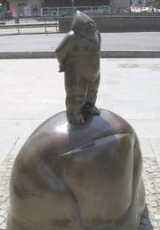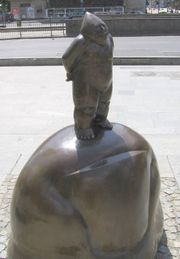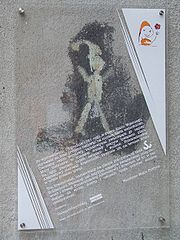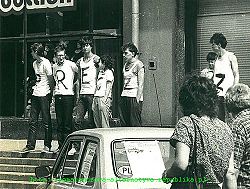
Orange Alternative
Encyclopedia
Orange Alternative is a name for an underground protest movement which was started in Wrocław, a town in south-west Poland
and led by Waldemar Fydrych (sometimes misspelled as Frydrych), commonly known as Major (Commander of the Festung
Breslau) in the 1980s. Its main purpose was to offer a wider group of citizens an alternative way of opposition against the authoritarian communist regime by means of a peaceful protest that used absurd and nonsensical elements.
By doing this, Orange Alternative participants could not be arrested by the police for opposition to the regime without the authorities becoming a laughing stock. Orange Alternative has been viewed as part of the broader Solidarity movement. Academics Dennis Bos and Marjolein t'Hart have asserted it was the most effective of all Solidarity's factions in bringing about the movement's success.
Initially it painted ridiculous graffiti
of dwarves on paint spots covering up anti-government slogans on city walls. Afterwards, beginning with 1985 through 1990, it organized a series of more than sixty happenings in several Polish cities, including Wrocław, Warsaw
, Łódź, Lublin
and Tomaszów Mazowiecki
.
It was the most picturesque element of Polish opposition to Stalinist authoritarianism
. It suspended activity in 1989, but reactivated in 2001 and has been active on a small scale ever since.
 A statue of a dwarf, dedicated to the memory of the movement, stands today on Świdnicka Street in Wrocław, in the place where events took place.
A statue of a dwarf, dedicated to the memory of the movement, stands today on Świdnicka Street in Wrocław, in the place where events took place.
Orange Alternative movement has inspired several other similar movements in authoritarian countries including Czechoslovakia
and Hungary
and it has also inspired and influenced the Pora
and the so called Orange Revolution
movement in Ukraine
, which was in turn supported by Poland.
Some utterances ascribed to Waldemar Fydrych:
 The first known actions of the Orange Alternative consisted of painting dwarf graffiti on spots created by the police
The first known actions of the Orange Alternative consisted of painting dwarf graffiti on spots created by the police
's covering up anti-regime slogans on walls of the Polish cities. The first graffiti was painted by Major Waldemar Fydrych and Wiesław Cupała on the night from the 30 to 31 August 1982 on one of the residences in the Wrocław district of Biscupin and Sępolno.
Altogether more than one thousand of such graffiti were painted in the major Polish cities such as Wrocław, Kraków
, Warsaw
, Łódź, and Gdańsk
.
Dwarves appearing in numbers all over Poland arose interest of both: Polish
pedestrians and the militia, whose intervention led to short term arrests of the graffiti artists.
During one of these incidents, Major, a detainee at a police station in Łódź, proclaimed, in reference to the marxist and hegelian dialectics, yet another artistic manifesto and referred to his graffiti art as "dialectic painting" stating: "The Thesis is the Anti-Regime Slogan. The Anti-thesis is the Spot and the Synthesis is the Dwarf. Quantity evolves into Quality. The more Dwarves there are, the better it is."
The first modest happening called the "Burning of Tubes" was organized as early as 1985 in Wrocław by Major Waldemar Fydrych accompanied by a small group of artists to which belonged: Krzysztof Skarbek, Piotr Petyszkowski, Andrzej Głuszek and Sławomir Monkiewicz.
The break-through moment came in the fall of 1987, during the Open Theatre Festival in Wrocław, when the Village Voice reported the Orange Alternative's action known as "Distribution of Toilet Paper" – a happening that laughed at the annoying, at the time, lack of that consumer product. After the publication of this article, the Orange Alternative became of interest to a number of Polish and foreign media.
The biggest happenings however took place in the years 1987 through 1989, with the "orange" wave spilling over Poland into cities such as Warsaw, Łódź, Lublin and Tomaszów Mazowiecki following Major Fydrych's arrest on 8 March 1988.
The actions of the Orange Alternative – although its leaders and participants often expressed anarchistic viewpoints – were not inherently ideological. No serious demands were ever expressed. Rather, the slogans were surrealist in character (such as "Vivat Sorbovit" (Sorbovit being a popular soft drink at that time) or "There is no freedom without dwarves." Often they paraphrased slogans used by the Solidarity Union or the communists. Their role was to laugh at absurds and pompousness of both sides of the system and provoke to independent thinking.
Their open street formula allowed all individuals to take part in the happenings. This openness drew thousands of pedestrians to participate in the group's actions. In such a way, the majority of the happenings could assemble thousands of participants, of whom many were accidental passers-by. The culmination point in the movement's history was the action organized on 1 June 1988, known as the "Revolution of Dwarves", during which more than 10 thousand persons marched through the center of Wrocław wearing orange dwarf hats.
The happenings usually terminated with the arrest of hundreds of participants, who did not manage to escape in time from the hands of the militia. The happeners were even able to provoke the communist militia to arrest at one point 77 Santa Clauses or, at another occasion, all people wearing anything red.
For everyone of its actions, the Orange Alternative printed leaflets and posters, featuring slogans like "Every militiaman is a piece of Art" or "Citizen, help the militia, beat-up yourself."
Poland
Poland , officially the Republic of Poland , is a country in Central Europe bordered by Germany to the west; the Czech Republic and Slovakia to the south; Ukraine, Belarus and Lithuania to the east; and the Baltic Sea and Kaliningrad Oblast, a Russian exclave, to the north...
and led by Waldemar Fydrych (sometimes misspelled as Frydrych), commonly known as Major (Commander of the Festung
Festung
Festung is a generic German word for a fortress. Whilst it is not in common usage in English it is used in a number of historical contexts involving German speakers:* For historical fortresses in Austria, Germany or Switzerland...
Breslau) in the 1980s. Its main purpose was to offer a wider group of citizens an alternative way of opposition against the authoritarian communist regime by means of a peaceful protest that used absurd and nonsensical elements.
By doing this, Orange Alternative participants could not be arrested by the police for opposition to the regime without the authorities becoming a laughing stock. Orange Alternative has been viewed as part of the broader Solidarity movement. Academics Dennis Bos and Marjolein t'Hart have asserted it was the most effective of all Solidarity's factions in bringing about the movement's success.
Initially it painted ridiculous graffiti
Graffiti
Graffiti is the name for images or lettering scratched, scrawled, painted or marked in any manner on property....
of dwarves on paint spots covering up anti-government slogans on city walls. Afterwards, beginning with 1985 through 1990, it organized a series of more than sixty happenings in several Polish cities, including Wrocław, Warsaw
Warsaw
Warsaw is the capital and largest city of Poland. It is located on the Vistula River, roughly from the Baltic Sea and from the Carpathian Mountains. Its population in 2010 was estimated at 1,716,855 residents with a greater metropolitan area of 2,631,902 residents, making Warsaw the 10th most...
, Łódź, Lublin
Lublin
Lublin is the ninth largest city in Poland. It is the capital of Lublin Voivodeship with a population of 350,392 . Lublin is also the largest Polish city east of the Vistula river...
and Tomaszów Mazowiecki
Tomaszów Mazowiecki
Tomaszów Mazowiecki is a town in central Poland with 67,159 inhabitants . Situated in the Łódź Voivodeship , it was previously part of Piotrków Trybunalski Voivodeship...
.
It was the most picturesque element of Polish opposition to Stalinist authoritarianism
Authoritarianism
Authoritarianism is a form of social organization characterized by submission to authority. It is usually opposed to individualism and democracy...
. It suspended activity in 1989, but reactivated in 2001 and has been active on a small scale ever since.

Orange Alternative movement has inspired several other similar movements in authoritarian countries including Czechoslovakia
Czechoslovakia
Czechoslovakia or Czecho-Slovakia was a sovereign state in Central Europe which existed from October 1918, when it declared its independence from the Austro-Hungarian Empire, until 1992...
and Hungary
Hungary
Hungary , officially the Republic of Hungary , is a landlocked country in Central Europe. It is situated in the Carpathian Basin and is bordered by Slovakia to the north, Ukraine and Romania to the east, Serbia and Croatia to the south, Slovenia to the southwest and Austria to the west. The...
and it has also inspired and influenced the Pora
Pora
PORA! , meaning IT'S TIME! in Ukrainian, is a civic youth organization and political party in Ukraine espousing nonviolent resistance and advocating increased national democracy...
and the so called Orange Revolution
Orange Revolution
The Orange Revolution was a series of protests and political events that took place in Ukraine from late November 2004 to January 2005, in the immediate aftermath of the run-off vote of the 2004 Ukrainian presidential election which was claimed to be marred by massive corruption, voter...
movement in Ukraine
Ukraine
Ukraine is a country in Eastern Europe. It has an area of 603,628 km², making it the second largest contiguous country on the European continent, after Russia...
, which was in turn supported by Poland.
Some utterances ascribed to Waldemar Fydrych:
- In Poland there are only three places when you can feel free: In churches, but only for the meditations, in prisons, but not everyone can go to prison, and on the streets: they are the freest places.
- The Western World will find out much more about the situation in Poland from hearing that I was put to jail for giving tampons to a woman, than from reading the books and articles written by other people from the opposition.
- Can you treat a police officer seriously, when he is asking you the question: "Why did you participate in an illegal meeting of dwarfs?"
The Beginnings
The beginning of the Orange Alternative are in a student movement called the Movement for New Culture created in 1980 at the University of Wrocław. It is in that year that Waldemar "Major" Fydrych, one of the movement's founders, proclaims the Socialist Surrealism Manifesto, which becomes the ideological backbone behind a gazette known as "The Orange Alternative." Seven out of the total fifteen issues of this gazette appear during student strikes organized in November and December 1980 as part of the Solidarity upheaval. The first number is edited jointly by Major Waldemar Fydrych and Wiesław Cupała (a.k.a. "Captain") simply with an idea to have fun. The editors treat the strike and the surrounding reality as forms of Art. For the ensuing numbers, the editorial committee is joined by Piotr Adamcio, known as "Lieutenant Pablo," Andrzej Dziewit and Zenon Zegarski, nicknamed "Lieutenant Zizi Top." Although its avantgarde character, according to the student strike organizers, was a threat to the "higher aims of the strike", and notwithstanding attempts by the strike committee to censor it, the gazette became rapidly very popular among the students.The Dwarves

Milicja Obywatelska
Milicja Obywatelska was a state police institution in the People's Republic of Poland. It was created in 1944 by Soviet-sponsored PKWN, effectively replacing the pre-war police force. In 1990 it was transformed back into Policja....
's covering up anti-regime slogans on walls of the Polish cities. The first graffiti was painted by Major Waldemar Fydrych and Wiesław Cupała on the night from the 30 to 31 August 1982 on one of the residences in the Wrocław district of Biscupin and Sępolno.
Altogether more than one thousand of such graffiti were painted in the major Polish cities such as Wrocław, Kraków
Kraków
Kraków also Krakow, or Cracow , is the second largest and one of the oldest cities in Poland. Situated on the Vistula River in the Lesser Poland region, the city dates back to the 7th century. Kraków has traditionally been one of the leading centres of Polish academic, cultural, and artistic life...
, Warsaw
Warsaw
Warsaw is the capital and largest city of Poland. It is located on the Vistula River, roughly from the Baltic Sea and from the Carpathian Mountains. Its population in 2010 was estimated at 1,716,855 residents with a greater metropolitan area of 2,631,902 residents, making Warsaw the 10th most...
, Łódź, and Gdańsk
Gdansk
Gdańsk is a Polish city on the Baltic coast, at the centre of the country's fourth-largest metropolitan area.The city lies on the southern edge of Gdańsk Bay , in a conurbation with the city of Gdynia, spa town of Sopot, and suburban communities, which together form a metropolitan area called the...
.
Dwarves appearing in numbers all over Poland arose interest of both: Polish
Poles
thumb|right|180px|The state flag of [[Poland]] as used by Polish government and diplomatic authoritiesThe Polish people, or Poles , are a nation indigenous to Poland. They are united by the Polish language, which belongs to the historical Lechitic subgroup of West Slavic languages of Central Europe...
pedestrians and the militia, whose intervention led to short term arrests of the graffiti artists.
During one of these incidents, Major, a detainee at a police station in Łódź, proclaimed, in reference to the marxist and hegelian dialectics, yet another artistic manifesto and referred to his graffiti art as "dialectic painting" stating: "The Thesis is the Anti-Regime Slogan. The Anti-thesis is the Spot and the Synthesis is the Dwarf. Quantity evolves into Quality. The more Dwarves there are, the better it is."
Happenings
What brought the Orange Alternative the biggest fame were its street happenings which it organized throughout the second half of the 1980s. These actions gained it enormous popularity among the Polish youth, who joined the movement, seeing it an alternative to the opposition style presented by the Solidarity, which they viewed as more stiff and boring.The first modest happening called the "Burning of Tubes" was organized as early as 1985 in Wrocław by Major Waldemar Fydrych accompanied by a small group of artists to which belonged: Krzysztof Skarbek, Piotr Petyszkowski, Andrzej Głuszek and Sławomir Monkiewicz.
The break-through moment came in the fall of 1987, during the Open Theatre Festival in Wrocław, when the Village Voice reported the Orange Alternative's action known as "Distribution of Toilet Paper" – a happening that laughed at the annoying, at the time, lack of that consumer product. After the publication of this article, the Orange Alternative became of interest to a number of Polish and foreign media.
The biggest happenings however took place in the years 1987 through 1989, with the "orange" wave spilling over Poland into cities such as Warsaw, Łódź, Lublin and Tomaszów Mazowiecki following Major Fydrych's arrest on 8 March 1988.
 |
 |
| PRECZ Z UPAŁAMI – "AWAY WITH SWELTER",if the person wearing letter 'U' shirt turns away the text says PRECZ Z PAŁAMI – "AWAY WITH BATONS" happening in Wrocław, July 1988) |
The actions of the Orange Alternative – although its leaders and participants often expressed anarchistic viewpoints – were not inherently ideological. No serious demands were ever expressed. Rather, the slogans were surrealist in character (such as "Vivat Sorbovit" (Sorbovit being a popular soft drink at that time) or "There is no freedom without dwarves." Often they paraphrased slogans used by the Solidarity Union or the communists. Their role was to laugh at absurds and pompousness of both sides of the system and provoke to independent thinking.
Their open street formula allowed all individuals to take part in the happenings. This openness drew thousands of pedestrians to participate in the group's actions. In such a way, the majority of the happenings could assemble thousands of participants, of whom many were accidental passers-by. The culmination point in the movement's history was the action organized on 1 June 1988, known as the "Revolution of Dwarves", during which more than 10 thousand persons marched through the center of Wrocław wearing orange dwarf hats.
The happenings usually terminated with the arrest of hundreds of participants, who did not manage to escape in time from the hands of the militia. The happeners were even able to provoke the communist militia to arrest at one point 77 Santa Clauses or, at another occasion, all people wearing anything red.
For everyone of its actions, the Orange Alternative printed leaflets and posters, featuring slogans like "Every militiaman is a piece of Art" or "Citizen, help the militia, beat-up yourself."
Sources
- Juliusz Tyszka. "The Orange Alternative: Street happenings as social performance in Poland under Martial Law." Cambridge.org, New Theatre Quarterly. vol. 14 (56), 1998. p. 00311
- Nicole Gourgaud. Doctoral thesis, Université de Lyon – November 1993
- The orange alternative, drukarnia Efekt, Warszawa 2008 – a very readable book about the movement from its very beginning

